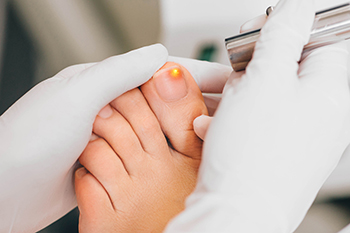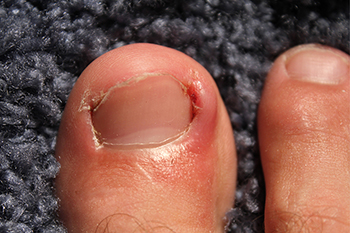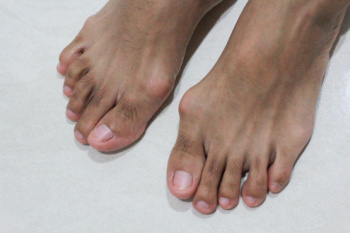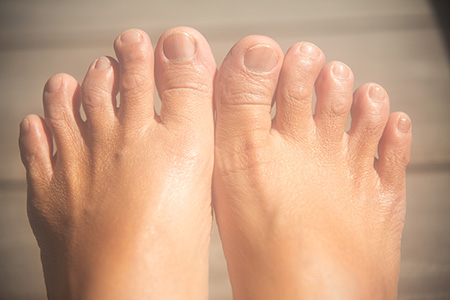Blog
Items filtered by date: October 2024
How Podiatrists Can Test for Gout

Gout is a type of arthritis that occurs when there is a buildup of uric acid in the body, leading to the formation of sharp crystals in the joints. This often results in sudden, severe pain and swelling, particularly in the big toe. When testing for gout, a podiatrist typically starts by reviewing a patient’s symptoms and history. To confirm a diagnosis, lab tests may be used, such as checking uric acid levels in the blood. A higher level of uric acid can indicate gout, but it is not always conclusive. Joint fluid analysis is a more definitive test, where fluid is taken from the affected joint and examined for uric acid crystals. Imaging tests like ultrasounds or X-rays may also be performed to detect urate crystals or rule out other conditions causing the joint pain. A podiatrist then monitors uric acid levels during treatment to ensure it is effective and adjusts the plan as needed. If you are experiencing big toe pain that may be caused by gout, it is suggested that you schedule an appointment with a podiatrist.
Gout is a foot condition that requires certain treatment and care. If you are seeking treatment, contact Stephanie Tine, DPM from Flamingo Foot and Ankle. Our doctor will treat your foot and ankle needs.
What Is Gout?
Gout is a type of arthritis caused by a buildup of uric acid in the bloodstream. It often develops in the foot, especially the big toe area, although it can manifest in other parts of the body as well. Gout can make walking and standing very painful and is especially common in diabetics and the obese.
People typically get gout because of a poor diet. Genetic predisposition is also a factor. The children of parents who have had gout frequently have a chance of developing it themselves.
Gout can easily be identified by redness and inflammation of the big toe and the surrounding areas of the foot. Other symptoms include extreme fatigue, joint pain, and running high fevers. Sometimes corticosteroid drugs can be prescribed to treat gout, but the best way to combat this disease is to get more exercise and eat a better diet.
If you have any questions please feel free to contact our office located in Fort Lauderdale, FL . We offer the newest diagnostic and treatment technologies for all your foot and ankle needs.
Why Live with Pain and Numbness in Your Feet?
Methods of Treating Toenail Fungus

Toenail fungal infections, or onychomycosis, can be treated through a variety of methods that focus on eliminating the fungus and improving the appearance of the affected nails. A podiatrist can provide guidance on nail care, suggest preventive measures, and recommend custom treatment plans based on the infection’s severity. Topical antifungal treatments, including medicated nail lacquers, may be recommended for mild to moderate cases. These products are applied directly to the nail but can take several months to show results. Oral antifungal medication may be prescribed for more severe infections, as they work systemically to target the fungus. However, there may be side effects, so the medication should only be taken under the supervision of a podiatrist. Laser therapy is another option for treating fungal toenails. This treatment involves using concentrated light to destroy fungal cells within the nail. If you have developed a toenail fungus, it is suggested that you schedule an appointment with a podiatrist for a diagnosis and treatment.
If left untreated, toenail fungus may spread to other toenails, skin, or even fingernails. If you suspect you have toenail fungus it is important to seek treatment right away. For more information about treatment, contact Stephanie Tine, DPM of Flamingo Foot and Ankle. Our doctor can provide the care you need to keep you pain-free and on your feet.
Symptoms
- Warped or oddly shaped nails
- Yellowish nails
- Loose/separated nail
- Buildup of bits and pieces of nail fragments under the nail
- Brittle, broken, thickened nail
Treatment
If self-care strategies and over-the-counter medications does not help your fungus, your podiatrist may give you a prescription drug instead. Even if you find relief from your toenail fungus symptoms, you may experience a repeat infection in the future.
Prevention
In order to prevent getting toenail fungus in the future, you should always make sure to wash your feet with soap and water. After washing, it is important to dry your feet thoroughly especially in between the toes. When trimming your toenails, be sure to trim straight across instead of in a rounded shape. It is crucial not to cover up discolored nails with nail polish because that will prevent your nail from being able to “breathe”.
In some cases, surgical procedure may be needed to remove the toenail fungus. Consult with your podiatrist about the best treatment options for your case of toenail fungus.
If you have any questions, please feel free to contact our office located in Fort Lauderdale, FL . We offer the newest diagnostic and treatment technologies for all your foot care needs.
Causes and Risks for Ingrown Toenails

Ingrown toenails develop when the nail grows into the surrounding skin, or when the skin grows over the edge of the nail. A primary cause of ingrown toenails is improper nail trimming, such as cutting the nail and rounding the edges instead of cutting straight across. This may result in the nail curling under and digging into the skin, which often results in pain as well as potential for infection. Other risk factors for ingrown toenails are wearing shoes that squeeze the toes, engaging in activities that put pressure on the feet, and having foot abnormalities like bunions or hammertoes. People with a family history of ingrown toenails, diabetes, or poor circulation are also more susceptible. Symptoms often include redness, swelling, and pain, and if untreated, can progress to infection. A podiatrist can assess and treat the condition, using techniques to relieve pain and in severe cases removing part of the nail or nail bed. If you have a painful or infected ingrown toenail, it is suggested that you schedule an appointment with a podiatrist.
Ingrown toenails may initially present themselves as a minor discomfort, but they may progress into an infection in the skin without proper treatment. For more information about ingrown toenails, contact Stephanie Tine, DPM of Flamingo Foot and Ankle. Our doctor can provide the care you need to keep you pain-free and on your feet.
Ingrown Toenails
Ingrown toenails are caused when the corner or side of a toenail grows into the soft flesh surrounding it. They often result in redness, swelling, pain, and in some cases, infection. This condition typically affects the big toe and may recur if it is not treated properly.
Causes
- Improper toenail trimming
- Genetics
- Improper shoe fitting
- Injury from pedicures or nail picking
- Abnormal gait
- Poor hygiene
You are more likely to develop an ingrown toenail if you are obese, have diabetes, arthritis, or have any fungal infection in your nails. Additionally, people who have foot or toe deformities are at a higher risk of developing an ingrown toenail.
Symptoms
Some symptoms of ingrown toenails are redness, swelling, and pain. In rare cases, there may be a yellowish drainage coming from the nail.
Treatment
Ignoring an ingrown toenail can have serious complications. Infections of the nail border can progress to a deeper soft-tissue infection, which can then turn into a bone infection. You should always speak with your podiatrist if you suspect you have an ingrown toenail, especially if you have diabetes or poor circulation.
If you have any questions, please feel free to contact our office located in Fort Lauderdale, FL . We offer the newest diagnostic and treatment technologies for all your foot care needs.
Do Bunion Correctors Work?

Bunion correctors are popular devices designed to straighten the big toe and provide relief for people with bunions. While they may help reduce discomfort when worn, they have not yet been shown to be effective in permanently realigning the toe or eliminating the bunion. Some people report pain relief while using these devices, especially when walking or standing for extended periods. However, research is inconclusive about whether bunion correctors prevent further progression of bunions. At this point, surgery is the only proven method for removing bunions. Even so, it is typically reserved for cases causing significant pain or gait problems. A podiatrist can advise by prescribing custom orthotics, recommending changes in footwear, or performing surgery. If you have a problematic bunion, it is suggested that you schedule an appointment with a podiatrist for an exam and suggested treatment options.
If you are suffering from bunion pain, contact Stephanie Tine, DPM of Flamingo Foot and Ankle. Our doctor can provide the care you need to keep you pain-free and on your feet.
What Is a Bunion?
Bunions are painful bony bumps that usually develop on the inside of the foot at the joint of the big toe. As the deformity increases over time, it may become painful to walk and wear shoes. Women are more likely to exacerbate existing bunions since they often wear tight, narrow shoes that shift their toes together. Bunion pain can be relieved by wearing wider shoes with enough room for the toes.
Causes
- Genetics – some people inherit feet that are more prone to bunion development
- Inflammatory Conditions - rheumatoid arthritis and polio may cause bunion development
Symptoms
- Redness and inflammation
- Pain and tenderness
- Callus or corns on the bump
- Restricted motion in the big toe
In order to diagnose your bunion, your podiatrist may ask about your medical history, symptoms, and general health. Your doctor might also order an x-ray to take a closer look at your feet. Nonsurgical treatment options include orthotics, padding, icing, changes in footwear, and medication. If nonsurgical treatments don’t alleviate your bunion pain, surgery may be necessary.
If you have any questions, please feel free to contact our office located in Fort Lauderdale, FL . We offer the newest diagnostic and treatment technologies for all your foot care needs.
Recognizing the Effects of Splayfoot

Splayfoot occurs when the metatarsal bones in the forefoot spread apart, causing the transverse arch of the foot to collapse. One common symptom of splayfoot is the feeling that your shoes are tighter or more uncomfortable than before. You may notice that your feet look wider, and foot pain typically worsens with walking or standing but eases with rest. Another indicator of splayfoot is the tendency to walk on the outer edges of your feet instead of pushing off with the big toe. This can cause your shoes to lean to one side when placed on a flat surface. Over time, painful calluses or pressure sores may form due to altered weight distribution. This can lead to foot deformities, fatigue, and even knee discomfort. If you observe these symptoms, a podiatrist can guide you on proper diagnosis and treatment options. If you are experiencing foot pain from splayfoot, it is suggested that you schedule an appointment with a podiatrist.
If you have any concerns about your feet, contact Stephanie Tine, DPM from Flamingo Foot and Ankle. Our doctor can provide the care you need to keep you pain-free and on your feet.
Biomechanics in Podiatry
Podiatric biomechanics is a particular sector of specialty podiatry with licensed practitioners who are trained to diagnose and treat conditions affecting the foot, ankle and lower leg. Biomechanics deals with the forces that act against the body, causing an interference with the biological structures. It focuses on the movement of the ankle, the foot and the forces that interact with them.
A History of Biomechanics
- Biomechanics dates back to the BC era in Egypt where evidence of professional foot care has been recorded.
- In 1974, biomechanics gained a higher profile from the studies of Merton Root, who claimed that by changing or controlling the forces between the ankle and the foot, corrections or conditions could be implemented to gain strength and coordination in the area.
Modern technological improvements are based on past theories and therapeutic processes that provide a better understanding of podiatric concepts for biomechanics. Computers can provide accurate information about the forces and patterns of the feet and lower legs.
Understanding biomechanics of the feet can help improve and eliminate pain, stopping further stress to the foot.
If you have any questions please feel free to contact our office located in Fort Lauderdale, FL . We offer the newest diagnostic and treatment technologies for all your foot and ankle needs.
